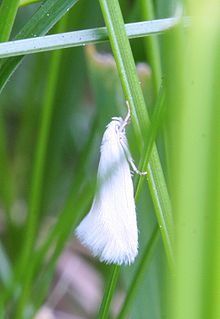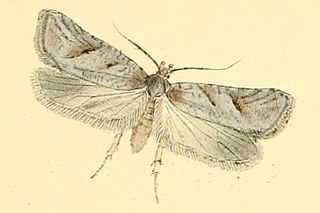| Stephensia | |
|---|---|
 | |
| Stephensia cedronellae | |
| Scientific classification | |
| Kingdom: | |
| Phylum: | |
| Class: | |
| Order: | |
| Family: | |
| Genus: | Stephensia Stainton, 1858 |
| Synonyms | |
| |
Stephensia is a genus of the small and very small moths of the family Elachistidae.
| Stephensia | |
|---|---|
 | |
| Stephensia cedronellae | |
| Scientific classification | |
| Kingdom: | |
| Phylum: | |
| Class: | |
| Order: | |
| Family: | |
| Genus: | Stephensia Stainton, 1858 |
| Synonyms | |
| |
Stephensia is a genus of the small and very small moths of the family Elachistidae.

The Elachistidae are a family of small moths in the superfamily Gelechioidea. Some authors lump about 3,300 species in eight subfamilies here, but this arrangement almost certainly results in a massively paraphyletic and completely unnatural assemblage, united merely by symplesiomorphies retained from the first gelechioid moths.

Gelechioidea is the superfamily of moths that contains the case-bearers, twirler moths, and relatives, also simply called curved-horn moths or gelechioid moths. It is a large and poorly understood '"micromoth" superfamily, constituting one of the basal lineages of the Ditrysia.

The Batrachedridae are a small family of tiny moths. These are small, slender moths which rest with their wings wrapped tightly around their bodies.

Pterolonchidae is a small family of very small moths in the superfamily Gelechioidea. There are species native to every continent except Australia and Antarctica.

Sterrhinae is a large subfamily of geometer moths with some 3,000 described species, with more than half belonging to the taxonomically difficult, very diverse genera, Idaea and Scopula. This subfamily was described by Edward Meyrick in 1892. They are the most diverse in the tropics with the number of species decreasing with increasing latitude and elevation.

Elachista is a genus of gelechioid moths described by Georg Friedrich Treitschke in 1833. It is the type genus of the grass-miner moth family (Elachistidae). This family is sometimes circumscribed very loosely, including for example the Agonoxenidae and Ethmiidae which seem to be quite distinct among the Gelechioidea, as well as other lineages which are widely held to be closer to Oecophora than to Elachista and are thus placed in the concealer moth family Oecophoridae here.
Stephensia armata is a Central American moth of the family Elachistidae and Gelechioidea superfamily, discovered in 1998 at Las Cuevas Research Station, in Belize's Chiquibul Forest Reserve.

Perittia is a genus of moths of the family Elachistidae.
Elachista zonulae is a moth of the family Elachistidae that is found in the Alps, the Tatra Mountains in Poland, the Tian Shan Mountains in Kazakhstan, Kyrgyzstan and Tajikistan and the Altai Mountains in Siberia.

Agonopterix is a moth genus of the superfamily Gelechioidea. It is placed in the family Depressariidae, which was often – particularly in older treatments – considered a subfamily of the Oecophoridae or included in the Elachistidae.
Coelopoeta is a relatively divergent genus of small moths in the superfamily Gelechioidea, which have only been found in western North America.

Exaeretia is a moth genus of the superfamily Gelechioidea. It is placed in the family Depressariidae, which is often – particularly in older treatments – considered a subfamily of Oecophoridae or included in the Elachistidae.

Gracillariinae are a subfamily of moths which was described by Henry Tibbats Stainton in 1854.
Elachista laquaeorum is a species of moth in the family Elachistidae. It was described by John S. Dugdale in 1971. It is found on the Snares Islands south of New Zealand.
Elachista archaeonoma is a species of moth in the family Elachistidae. It was described by Edward Meyrick in 1889. It is endemic to New Zealand.
Elachista helia is a moth in the family Elachistidae. It was described by Lauri Kaila and Sruoga in 2014. It is found only on Rhodes in Greece.
Perittia tectusella is a moth in the family Elachistidae. It was described by Sruoga in 1997. It is found in Central Asia, where it has been recorded from Tajikistan.
Stephensia jalmarella is a moth in the family Elachistidae. It was described by Lauri Kaila in 1992. It is found in the Altai Mountains.
| This article on a moth of the family Elachistidae is a stub. You can help Wikipedia by expanding it. |